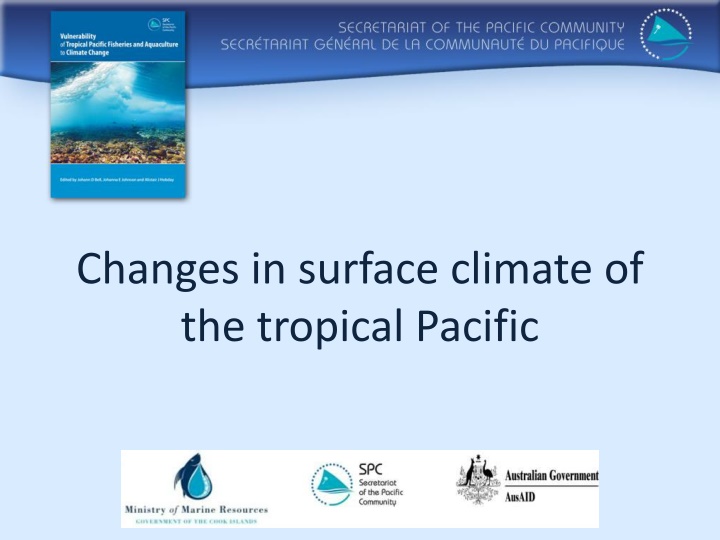
Insights into Changes in Tropical Pacific Climate System
Explore the surface climate changes in the tropical Pacific region and the impact on atmospheric circulation, sea surface temperatures, and the El Niño-Southern Oscillation (ENSO). Learn about typical El Niño and La Niña patterns, their effects on rainfall and temperature, and the shifts in tropical cyclones due to ENSO. Understand the implications of climate change and extreme weather events in the foreseeable future.
Download Presentation

Please find below an Image/Link to download the presentation.
The content on the website is provided AS IS for your information and personal use only. It may not be sold, licensed, or shared on other websites without obtaining consent from the author. If you encounter any issues during the download, it is possible that the publisher has removed the file from their server.
You are allowed to download the files provided on this website for personal or commercial use, subject to the condition that they are used lawfully. All files are the property of their respective owners.
The content on the website is provided AS IS for your information and personal use only. It may not be sold, licensed, or shared on other websites without obtaining consent from the author.
E N D
Presentation Transcript
Changes in surface climate of the tropical Pacific
Outline and key messages Main features of region s climate system We are affecting the climate system - climate is already changing Future will be warmer Extreme weather likely to be more extreme Our climate will be changing for foreseeable future
Pacific atmospheric circulation Trade winds Convergence zones Walker and Hadley circulations
El Nio-Southern Oscillation (ENSO) Major source of year-to-year climate variations
Typical El Nio and La Nia rainfall patterns Wetter (green) or drier (orange)
Typical El Nio and La Nia rainfall Annual rainfall Pehnryn
Typical El Nio and La Nia temperature Annual temperature Rarotonga
Effects of El Nio and La Nia on SST Warmer (red) or cooler (blue)
ENSO shifts SPCZ and tropical cyclones El Ni o Further north El Ni o Further south La Ni a La Ni a Fewer cyclones further east El Ni o More cyclones further west La Ni a
Cyclones in Cook Islands Number of cyclones passing within 400 km of Rarotonga
Redistributing suns energy = climate system Without the atmosphere the Earth would be ~30oC cooler More greenhouse gases trap more energy in climate system
Why are climate scientists so sure climate is changing due to human activities? Theory Modelling Evidence: instrumental measurements changes in the physical world changes in the biological world paleoclimate archives The climate system appears to be changing faster than earlier thought likely Steffen 2009
Measured increase in carbon dioxide 18thcentury = 280ppm air bubbles in ice cores 2011= 391ppm Mauna Loa
Projecting future climates Emissions Scenario IPCC-AR4 (2007) Low (B1) 450-500 ppm CO2 High (A2) 750-800 ppm CO2 Temperature (oC) Rainfall 2035 2050 2100 2035 2050 2100 0.5-1.0 ? 1.0-1.5 5-15% 10-20% 10-20% 0.5-1.0 1.0-1.5 2.5-3.0 5-20% 10-20% 10-20% Predicting future forcing how much more greenhouse gases? Range of possible futures but the future will be WARMER
Cook Islands temperature projections Northern Group - increase in temperature of 0.5 0.9oC Southern Group - increase in temperature of 0.4 1.0oC More hot days and warm nights Decline in cooler weather.
Cook Islands rainfall projections Uncertainty around rainfall because model results are not consistent but generally projected to increase For the Southern Group, average rainfall during the wet season is expected to increase due to intensification of SPCZ Droughts are projected to become less frequent throughout this century
Cyclones Cook Islands projections indicate there is likely to be a decrease in the number of tropical cyclones by the end of the 21st century But there is likely to be an increase in average maximum wind speed of cyclones by between 2% and 11%
Extremes The answer to the oft-asked question of whether an event is caused by climate change is that it is the wrong question All weather events are affected by climate change because the environment in which they occur is warmer and moister than it used to be Trenberth 2012
Important points to note Extremes will become more extreme Unclear how ENSO will change continued influence
Summary Not just a new climate to which we can adapt . For foreseeable future, climate will be CHANGING
